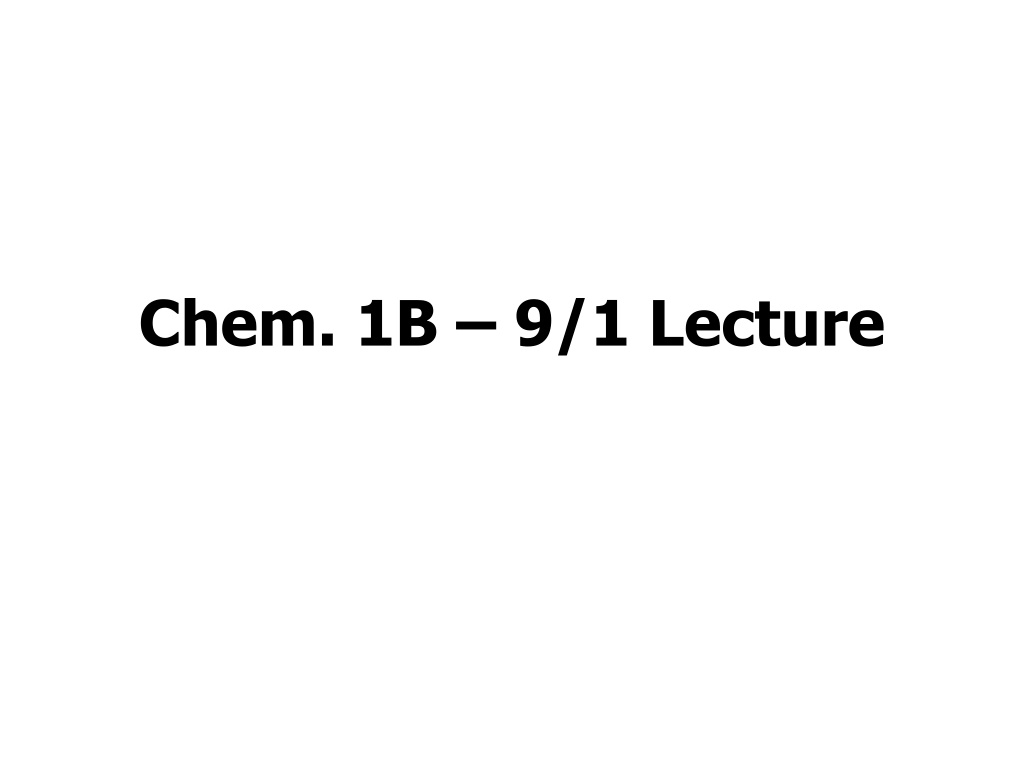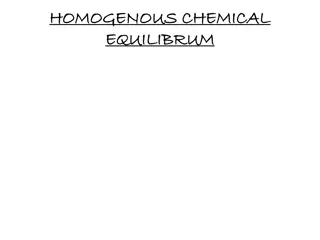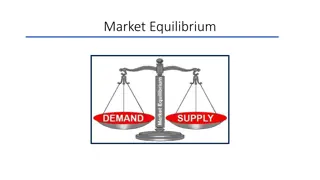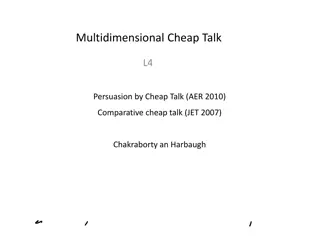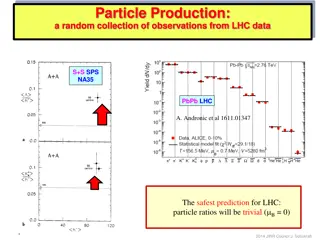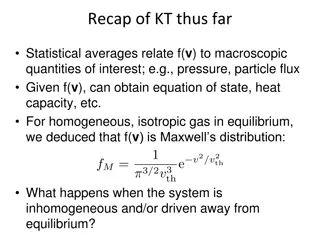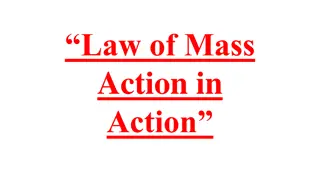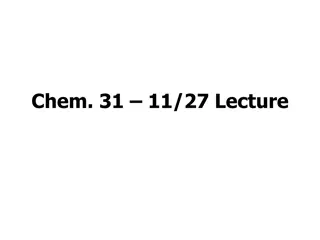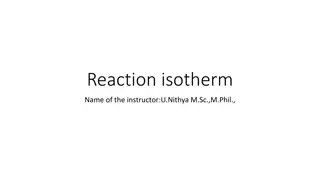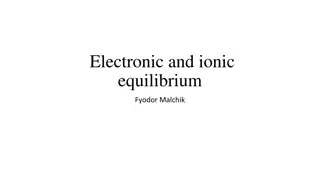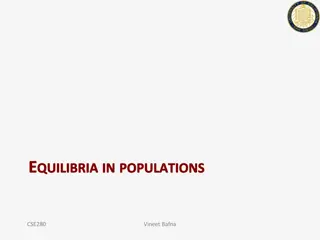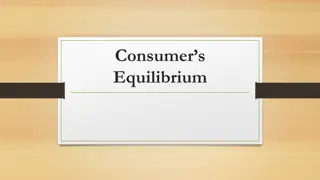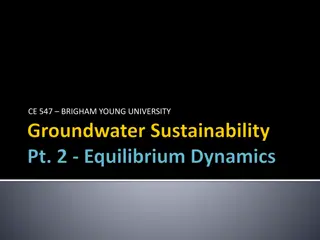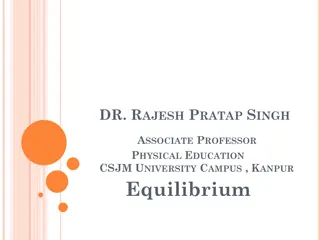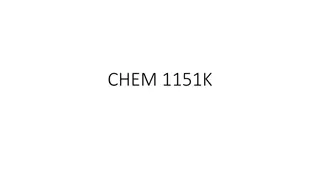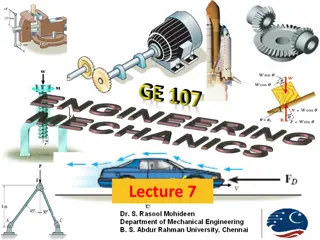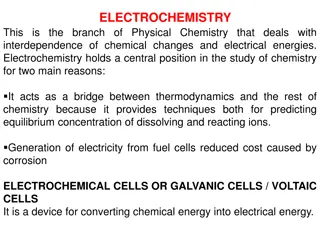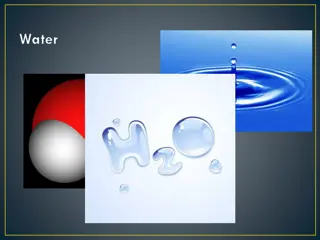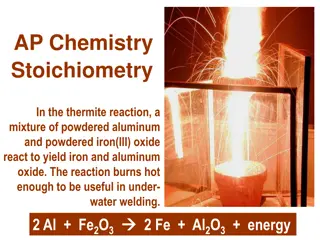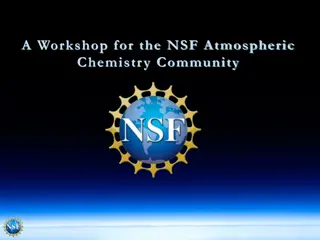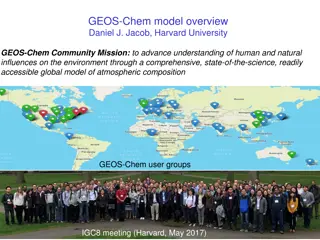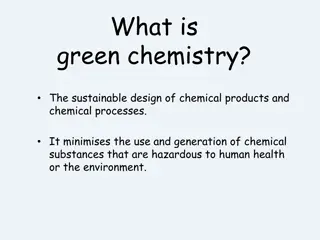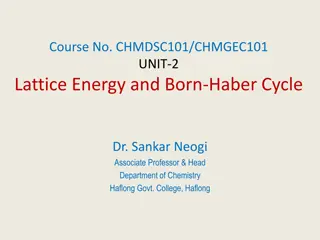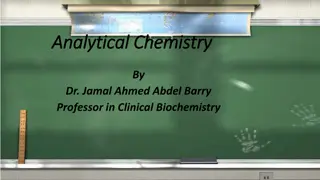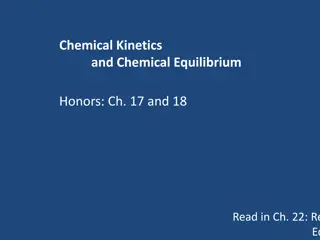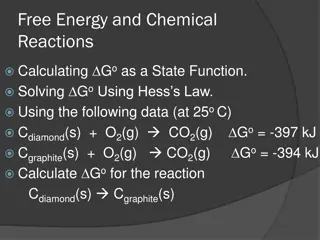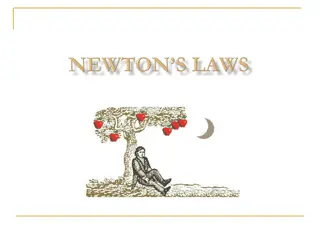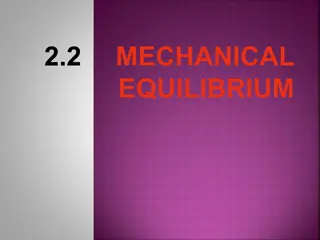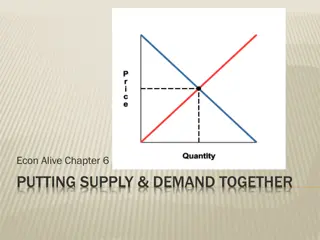Understanding Chemical Equilibrium in Chemistry
Exploring the concept of chemical equilibrium in chemistry, where reactions can occur in both forward and reverse directions to an appreciable extent. Learn about basic equilibrium principles, equilibrium problems, manipulating reactions, and common example problems in nomenclature. Understand how reactions reach equilibrium when the forward and backward rates are equal, and concentrations remain constant. Dive into the topic with practical examples and announcements regarding upcoming quizzes and review sessions.
Download Presentation

Please find below an Image/Link to download the presentation.
The content on the website is provided AS IS for your information and personal use only. It may not be sold, licensed, or shared on other websites without obtaining consent from the author. Download presentation by click this link. If you encounter any issues during the download, it is possible that the publisher has removed the file from their server.
E N D
Presentation Transcript
Announcements I Diagnostic Quiz Should be receiving back in lab Learn what material to review SacCT will be set up once adding is done Bring a periodic table to class (I will provide on on exam days) Today s Lecture note: not covered in same order as in text More Review (I will stress what people had difficulty with)
Announcements II Today s Lecture cont. Basic Equilibrium (and Questions) Manipulating Reactions KPvs. KC Equilibrium Problems: STARTING AT EQUILIBRIUM Equilibrium Problems: STARTING AT INITIAL CONDITIONS (if time)
Chem 1A Review A Few More Example Problems Nomenclature Cerium (IV) dichromate (cerium = Ce) Type = ____________ formula = _____________ perchloric acid type = ______ formula = ____ Cu2SO4type = ______ name = ____ How many g. of Cu2SO4are needed to prepare 25.0 mL of a solution that is 0.400 M Cu+?
Chem 1B First Topic Equilibrium In Chapter 13 (near end of Chem 1A), we covered kinetics (how fast reactions occur) Past assumption was that meant reaction went to completion (all products plus limiting reagent) Also, unfavorable reactions, such as precipitation of CaCl2from Ca2++ Cl-are not supposed to occur at all In some important cases, expected reactions will not proceed totally to completion and unexpected reactions can occur to some extent
Chem 1B - Equilibrium Introduction Reactions that can occur in both the forward and reverse reactions to an appreciable extent are represented with a two way arrow: A + B C or A + B What does this mean? From a molecular scale, reactions are occurring in both the forwards and backwards direction When the forward rate (loss of A to form C) is equal to the backwards rate (gain of A from C), the system is said to be in equilibrium and concentrations don t change C (easier to type this)
Chem 1B - Equilibrium Introduction Graphic example of reaction: A + B C (assume [A] = [B] at start) In the beginning, forward rate is fast (as A and B are high). At the points the lines cross, [A] = [B] = [C], but the forward rate is still faster than the backwards rate. We can see that [C] is favored over [A] and [B] because its final conc. is higher. Conc. (C) Conc. (A and B) Time
Chem 1B - Equilibrium Introduction Some examples: 1. Carbon dioxide (CO2) is not very soluble (you are supposed to know it forms from acid + carbonates) However, the acidity of rain in pristine conditions is supposed to be based on dissolution of CO2: CO2 (g) + H2O (l) H2CO3 (aq) 2. Nitrogen gas (N2) is difficult to react because of the strength of its triple bonds, however under certain conditions, beneficial and problematic reactions involve N2 where both reactants and products exist. a) N2 (g) + 3H2 (g) 2NH3 (g) (used in fertilizer) b) N2 (g) + O2 (g) 2NO (g) (source of smog from combustion) Conditions are critical to make a) go but to limit b) H+ + HCO3-
Chem 1B - Equilibrium Equilibrium Constant and Equation Whether an equation favors reactants or products is determined by an EQUILIBRIUM CONSTANT (K) as well as reaction stoichiometry Generic reaction: aA + bB K = equilibrium constant and for above reaction, b B A cC + dD c d C D K = a A larger K value means products are more favored (bigger [C] and [D] vs. [A] and [B])
Chem 1B - Equilibrium Equilibrium Equation Further Details Technically, instead of concentration we have a concentration ratio to a standard state (e.g. 1 mol/L) we can ignore this, but this is why K is unitless Only species in gas phase or in solution will have concentrations. Solids and pure liquids are not included. When gases are involved, there are two Ks: KC for concentration units (including gases) and KP in which pressure (atm) replaces concentration (assume K = KC unless specified) Even further corrections (activity and fugacity) are needed under certain conditions but are beyond this class
Chem 1B - Equilibrium Equilibrium Equation Example N2 (g) + O2 (g) 2NO (g) N 2 2 P NO KC= or K = NO P O P P N O 2 2 2 2 At T = 25 C KC = KP (in this case) = 4 x 10-31 Almost no NO will form in air: PN2 = 0.8 atm , PO2 = 0.2 atm; rearranging the above equation, PNO = [KPPN2PO2]0.5 = 2 x 10-16 atm Equilibrium at room temp. is not realistic because kinetics is too slow (insufficient collision energy to break triple bond), so even less NO expected At car engine temp., reactions are faster and K is much larger (even if <1). This leads to significant NO formation. Fuel rich conditions (low PO2 ) can limit NO formation (reducing PO2 reduces PNO).
Chem 1B - Equilibrium Equilibrium Equation Questions I If the following reaction is at equilibrium, which of the following statements is true: 2NO2 (g) N2O4 (g) a) the concentrations of reactants and products are equal b) the rate of formation of N2O4 (M/s) is equal to its loss (in M/s) c) the rate of loss of NO2 in forming N2O4 is equal to the rate of loss of N2O4 in forming NO2 d) neither molecule is reacting at all as their concentrations are constant
Chem 1B - Equilibrium Equilibrium Equation Questions II For the following reactions, give an equilibrium equation: CH4(g) + H2O(g) CO(g) + 3H2(g) H2(g) + I2(s) 2HI(g) S(s) + 3F2(g) SF6(g) AgCl(s) + 2NH3(aq) Ag(NH3)2+(aq) + Cl-(aq) What are the units for the K value for the first reaction? Given the reactions and K values, for which reaction is formation or products most likely? 4Cu(s) + O2(g) 2Cu2O(s) 2Cu(s) + O2(g) 2CuO(s) 2Cu(s) + H2O(l) Cu2O(s) + H2(g) K = 1.0 x 10-16 K = 3.9 x 1025 K = 1.8 x 1022
Chem 1B - Equilibrium Equilibrium Equation Manipulating Equations This is similar to Hess s Law (used to calculate H for a reaction which can be made from combinations of other reactions) Rules: Flipping Directions If for A B, K = K1, then for B Multiplication N2 (g) + O2 (g) NO (g) K = K1 N2 (g) + O2 (g) 2NO (g) = 2 RXN1, then K = K12 A, K = 1/K1
Chem 1B - Equilibrium Equilibrium Equation Manipulating Equations Rules: - cont. Adding Reactions: N2 (g) + O2 (g) 2NO (g) + O2 (g) N2 (g) + 2O2 (g) Rxn 3 = rxn 1 + rxn 2 Why is math different than Hess s Law? Covered in detail in Ch. 17, but short reason: G (somewhat like H) = -RTlnK And from math we know ln(K1 K2) = lnK1 + lnK2 Thus addition in reaction becomes multiplication in K 2NO (g) K = K1 2NO2 (g) K = K2 2NO2 (g) K = K3 K3 = K1 K2
Chem 1B - Equilibrium Equilibrium Equation Manipulating Equations If the following reactions have the given equilibrium constants: 1) Ag+ + 2NH3(aq) Ag(NH3)2+ K = 1.70 x 107 2) NH3(aq) + H2O(l) NH4+ + OH- K = 1.76 x 10-5 3) H2O(l) H+ + OH- K = 1.0 x 10-14 Example Problem: Determine the equilibrium constant for the following reaction: Ag(NH3)2+ + 2H+ Ag+ + 2NH4+
Chem 1B - Equilibrium Equilibrium Constants KP vs. KC Are KP and KP the same? If not how are they related? Q1 No (except for some reactions) Q2 How is P related to C? Ideal gas law: PV = nRT And we know [] is moles gas/volume = n/V We can rearrange the ideal gas law to: P = (n/V)RT = []RT
Chem 1B - Equilibrium Equilibrium Constants KP vs. KC Example: 2NO2 (g) N2O4 (g) KP = PN2O4/PNO22 Or KP = ([N2O4]RT)/([NO2]RT)2 = KC(RT)-1 General Rule: KP = KC(RT) n where n = change in number of moles (moles gas product moles gas reactants) = 1 2 = -1 in above example
Chem 1B - Equilibrium Most Common Types of Problems Conditions given Question Asking for K Question Asking for Equilibrium Concentrations Only at equilibrium Requires knowledge of concentrations (or pressures) of all species Requires knowledge of K and concentrations of all but one species Initial conditions (requires use of ICE table) Usually requires equilibrium concentration of at least 1 species Requires knowledge of K
Chem 1B - Equilibrium Equilibrium Problems AT EQUILIBRIUM In this case the equilibrium equation is used with concentrations (or pressures) given AT EQUILIBRIUM These types of problems are very important for environmental chemistry, but underemphasized in text For example, an atmospheric chemist measured high NO in air near fresh lava. He wondered if it came from the N2(g) + O2(g) reaction. If KP(T = 1000 K) = 7 x 10-9, calculate PNO in equilibrium with N2 and O2 in air. 2NO(g)
Chem 1B - Equilibrium Equilibrium Problems AT EQUILIBRIUM A rich chemist wants to measure KC for the reaction: N2O4 (g) 2NO2 (g) He puts N2O4 in a container at the temperature he wants to measure KC. He measures [NO2] and [N2O4] (using an expensive mass spectrometer) until the concentrations stop changing. He finds [NO2] = 0.0311 M and [N2O4] = 0.000170 M. What is KC? 2nd Example Problem:
Chem 1B - Equilibrium Equilibrium Problems Starting from initial conditions In this case an initial concentration or pressure is given (typically of reactants) The reaction then proceeds to equilibrium The student calculates K or the concentration of a reactant or product An important part of working out this problem is to make an ICE table ICE stands for initial change equilibrium
Chem 1B - Equilibrium Equilibrium Problems Starting from initial conditions To understand how an ICE table works, let s start with a reaction that goes 100% to completion (covered in Chem 1A) Example: 1.00 mol/L H2 + 1.00 mol/L O2 going to H2O in a container at 200 C. reaction 2H2(g) + O2(g) 2H2O(g) initial conc. 1.00 mol/L 1.00 mol/L 0 change -1.00 mol/L -0.50 mol/L +1.00 mol/L completion 0 mol/L 0.50 mol/L 1.00 mol/L mol/L O2 lost = (1.00 H2 mol /L)(1 mol O2/2 mol H2) limiting reagent remember: for every 2 mol H2 we use 1 mol O2
Chem 1B - Equilibrium Equilibrium Problems Starting from initial conditions Example Problem: The rich chemist lost his research grant and had his mass spectrometer repossessed. He still has a UV-Visible spectrometer to measure [NO2] (it s a brown gas while N2O4 is invisible). Can he still calculate K? Yes, but we need to define the experiment more carefully Initially, the chemist puts 0.0100 mol N2O4 into a 5.0 L container and sets T. He measures [NO2]. When the concentration stops increasing, he finds [NO2] = 0.0028 M. What is K?
